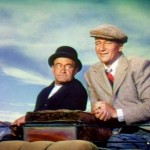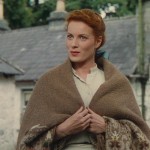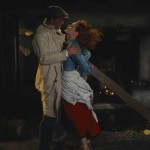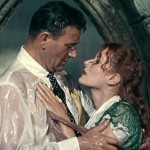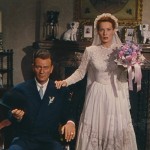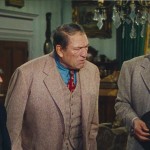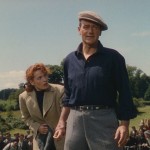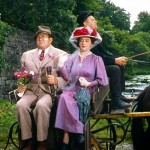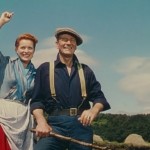
The Quiet Man – 1952
My opinion of this film is divided. On the one hand, it had a cute story and most of the acting was good. On the other hand, the principles behind the story are either very antiquated, extremely sexist, or both. It starred John Wayne in a role that was not quite typical for him, and Maureen O’Hara, in a role that was easily typical for her.
The plot centered around Sean Thornton, an ex-boxer from Pittsburgh who has a dark secret in his past. He moves to Inisfree, the small Irish town in which he was born. He is met by the quirky and quaint townsfolk, and in particular, by Michaeleen Flynn, wonderfully played by Barry Fitzgerald, who offers him a carriage ride back to his ancestral home. Before they arrive, they pass a woman tending a flock of sheep. Their eyes meet and lock, and that’s all she wrote. They are madly in love with each other.
The shepherdess is the fiery red-head, Mary Kate Danaher, played by Maureen O’Hara. She is known for having a temper. The film’s main complication comes in the form of Mary Kate’s older brother, Will, played by Victor McLagen. He has interests in purchasing the vacant property in which Sean intends to live. But when Sean buys it out from under him, he is infuriated. In retaliation, he refuses to give his sister permission to marry the Yankee.
What follows is a little pastiche that shows the strange and antiquated customs of the land, specifically in regards to proper courtship. But in the end of the film, the final ten minutes, their differences are resolved in a grand and somewhat comedic brawl between the two opponents. After refusing to fight for the entire film, Sean proves his love for Mary Kate for all to see. He not only earns her respect, but the respect of Will, himself. Once they have beaten the crap out of each other, they get drunk and stumble home, leaning on each other and singing together.
And there is Mary Kate, waiting at the house with dinner sitting on the table. She scolds the two drunkards while trying to hide her grin. Incidentally, she did that several times in the course of the movie. She yelled at the men for behaving like men, but her hidden grin tells the audience that she is actually pleased, and possibly even a little turned on, by their manly misbehaving, presumably because it is how “real men” should act.
But therein lies the heart of the plot’s main failing. The film is incredibly sexist. First, it says that women are only truly happy when they are cooking and cleaning for a man. Men are only truly happy when they are getting drunk and fighting. Second, it is not only a husband’s prerogative to beat his wife when she misbehaves, it is his duty. At one point, when Sean is physically abusing Mary Kate for being a bad wife, in front of the entire town, no less, an old woman actually hands Sean a large switch with witch to more efficiently beat his bride. And third…well, there isn’t a third, but aren’t the first two enough?
Still, despite its antiquated, sexist ideals, it was still a fun movie to watch. It had a bit of humor, a bit of heart, and a bit of drama. It didn’t take itself too seriously, which was all for the better. And I have to make special mention of the fantastic cinematography. Winton C. Hoch and Archie Stout did a fantastic job of showing off the Irish Countryside in a way that was grand and inspiring, yet at the same time, they captured the feel of the small and charming village of Inisfree, despite the fact that it was a fictional town.
I mentioned earlier that most of the acting was good. Unfortunately, I was slightly disappointed in the film’s lead, John Wayne. He was out of his element and it showed. Everyone was used to seeing him play the parts of cowboys and war heroes. But when he was walking down the streets of the town, he still had that cowboy swagger that he was known for. It was a walk that made him look like he had a bad leg and swishy arms. It was either that, or he was drunk. I suspect that it might have just been his own way of walking, slightly hunched over and swaying. Either way, it looked really out of place and I sometimes had trouble seeing the character of Sean Thornton instead of actor, John Wayne.
